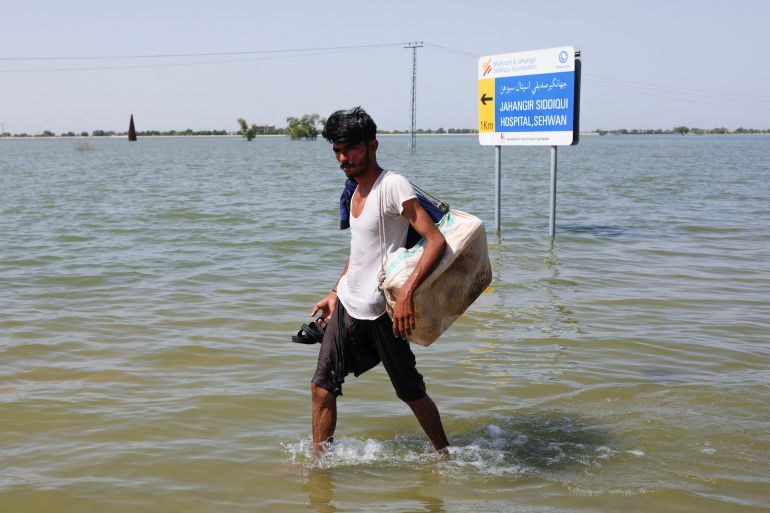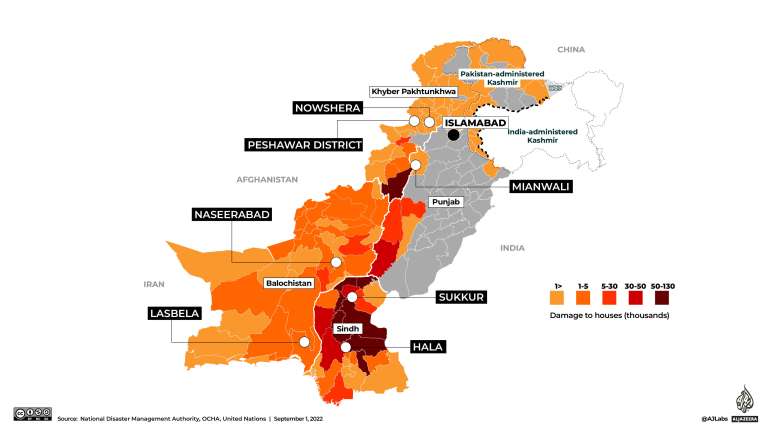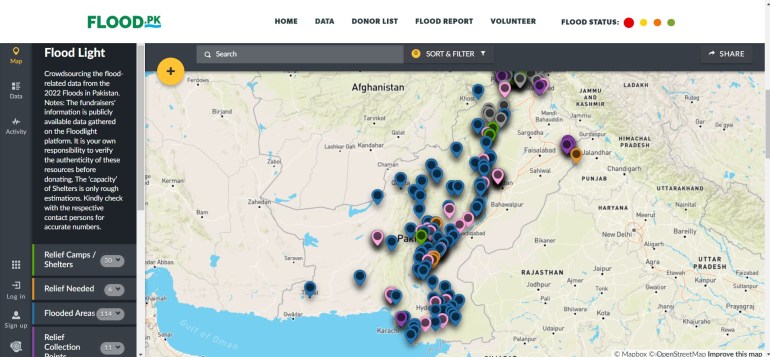How Pakistani entrepreneurs stepped in after flood disaster
Dozens of entrepreneurs and non-profits came forward to help flood survivors as the country was overwhelmed by its worst flooding in decades.

Jamshoro, Pakistan – Monsoon floods ravaged large parts of Pakistan last month, overwhelming disaster management efforts. But non-profits and dozens of entrepreneurs, old and young, stepped in as their country faced its worst disaster in decades.
There’s a huge need for everything – from tents to blankets, from mosquito nets to water purification, from food to hygiene kits, and from anti-malarial medicines to basic fever medication.
Keep reading
list of 4 itemsClimate Change: Leaving Pakistan out to dry
Global warming, man-made factors worsened Pakistan floods: Study
Mapping the scale of damage by the catastrophic Pakistan floods
“Millions and millions of people have no access to water, shelter and food. We have seen children who are malnourished and suffering from skin diseases, diarrhoea, everything you can imagine,” Abdullah Fadil, the Pakistan representative for the United Nations Children’s Fund (UNICEF), told Al Jazeera.
Fadil said more resources are needed, such as medicines and therapeutic food for children and lactating and pregnant mothers, 680,000 of whom are among the flood-affected 33 million people.
“We need the world to really pay attention to the dire needs of children and mothers of Pakistan. I hope the world will pay attention to this calamity caused by climate change,” he said.
Last week, UN chief Antonio Guterres said he had not seen a ‘climate carnage on this scale’ after visiting the flood-affected South Asian nation.
The international response has been slow so far, so some Pakistanis are trying their best to help fellow citizens. Here are a few of their stories.

Shelter
The deluge has damaged or destroyed more than 1.5 million homes. For weeks, people had to endure pouring rain and scorching sun as they had no shelter. Thousands of Pakistanis have donated tents and tarps so people can find some respite.
Muhammad Omar, an advertising executive in the southern port city of Karachi, thought the best way forward would be to rely on Panaflex sheets being used on billboards.
“All we did was to cut them in a four-metre by three-metre rectangle, ask our team to install metal rivets so they can be put on hooks or tied with strings, and voila we had cost-effective and easy-to-deploy shelters which could provide some shade for desperate families made homeless by the floods,” Omar told Al Jazeera.
Since then, Omar and a group of volunteers have helped raise more than $40,000 for dozens of tents and managed to transport them on lorries, helicopters and boats to far-flung areas, including Keti Bunder, Kachee, Jhal Magsi, Gandakha, Sukkur and Khairpur in southern Sindh province – the area worst affected by the flooding.
Tent manufacturers have found this crisis to be their opportunity, and hundreds of small and medium factories have popped up in major cities.
Water everywhere, not a drop to drink
Millions of people are drinking contaminated water in Pakistan, and some are forced to drink from pools with dead cattle floating in them.
“UNICEF has distributed millions of litres of water, but that’s a drop in the ocean of what people need,” Fadil, the UNICEF representative, said.
The World Health Organization has warned of multiple disease outbreaks because of unsanitary conditions for those displaced by the floods.
Economist Hamza Farrukh has worked on providing clean water without using electricity since 2014. Farrukh through his non-profit Bondh-E-Shams – which translates to “droplets of the sun” – has used a solar-powered water filtration unit to purify contaminated water.
The Solar Water Box provides a robust, on-wheels, solar-powered water filtration unit that can deliver up to 10,000 litres of filtered water per day, he says.
Quickly scaling up to 50 boxes a month, dozens of solar boxes have been deployed to aid flood survivors in Punjab, Khyber Pakhtunkhwa and Sindh provinces. Filtered water can help control water-borne diseases in addition to preventing people from becoming dehydrated.
The box is a semi-permanent solution because once flood waters recede, the same units can be relocated to permanent water sources in villages.
Bondh-E-Shams, Farrukh says, has delivered an estimated 50 million cups of clean water to 40 communities around the world, including to the Rohingya in Bangladesh and to others in need in Afghanistan, South Sudan, Yemen and Pakistan.
His aim is “to help diminish the global water crisis by 2050”.
Another startup, called PakVitae, is providing a filter product that does not require electricity. Using gravity and attaching to the bottom of water containers, the filters can provide up to 10,000 litres.
Jarri Masood, a management consultant for PakVitae, says filters made from fibre membranes are used to eliminate most impurities and bacteria.
Since the floods began, PakVitae has donated some units and also started providing filters to relief workers. They have reduced the price: instead of 5,000 rupees ($22), they charge 4,000 rupees ($18) for flood relief, and they have added a 15-litre jerry can per unit for flood relief units.

No electricity, no lights
It’s pitch-dark at night for tens of thousands of people living on small sections of dry land in most parts of Sindh, including Jamshoro. At least 101 people have been treated for snake bites and 550 for dog bites.
Businessman Raza Zubair heard about the plight of the flood victims during a Friday sermon. He and his friends have provided solar-powered lamps for the survivors.
Their lightweight solar lamps have offered much-need illumination for thousands.
Like other volunteers, Zubair, who owns the Sun King solar business, is also distributing essentials including food rations, medicines, mosquito nets, and toiletries.
His company has reduced the price of the basic solar lamps for flood victims and also introduced lanterns, which can recharge phones as well. A solar lamp now costs 1,000 rupees ($4.50) instead of 1,600 ($7.20), and a solar lantern costs 4,000 rupees ($18) instead of 6,500 ($29)
Relief aggregator
When many citizens, government agencies and NGOs start helping people, there’s the risk of duplication and aid not reaching the right people.
Shafeeq Gigyani, the co-founder of Enlight Lab, was frustrated with not being able to get relevant statistics for his ancestral village on the bank of Swat river in the northern Khyber Pakhtunkhwa province.
Enlight Lab, a non-profit, decided to collate data for flood-affected areas across Pakistan. The company came up with Flood.PK – a crowdsourced platform for those affected by the flood to call for help and for field teams to respond to them.
Gigyani, who is based in Peshawar, says having this data streamlines shelter, relief, medical aid, volunteer help and fundraising while also answering some questions about the floods.
Other aggregators and crowd-sourced platforms such as FloodLight are also providing similar data sets for volunteers and victims.

Rehabilitation
As relief and rescue winds down, the glaring question is what comes next after the waters recede and the devastation remains. The main task of rehabilitation would require providing houses for hundreds of thousands of people.
How does a cash-strapped, debt-ridden economy pay for it?
Miran Saifi and three others founded Modulus Tech in 2017 to address the housing shortages in Pakistan. Even before the devastating floods, the country had a housing gap of 10 million.
Modulus Tech aimed to provide easily assembled houses for refugees globally.
The team at Modulus Tech is developing long-term solutions for flood survivors by designing homes that are low-cost and can be set up immediately.
They are using non-conventional methods of construction and off-grid solutions through responsible sourcing of sustainable and lightweight materials. They claim their homes now pollute 90 percent less than traditional home construction.
Afia Salam, president of the board at Indus Earth Trust, says long-term rehabilitation solutions are equally as important as urgent relief.
Along with her colleagues, she is trying to generate funds to reconstruct houses by training masons and supervisors from flood-affected areas. Their designs include cost-effective, locally sourced houses that have a lower carbon footprint as well.
This is neither a comprehensive nor exhaustive list, but a small representation of the hundreds of organisations old and new and the tens of thousands of selfless volunteers who are serving Pakistan as it passes through its worst climate calamity.
